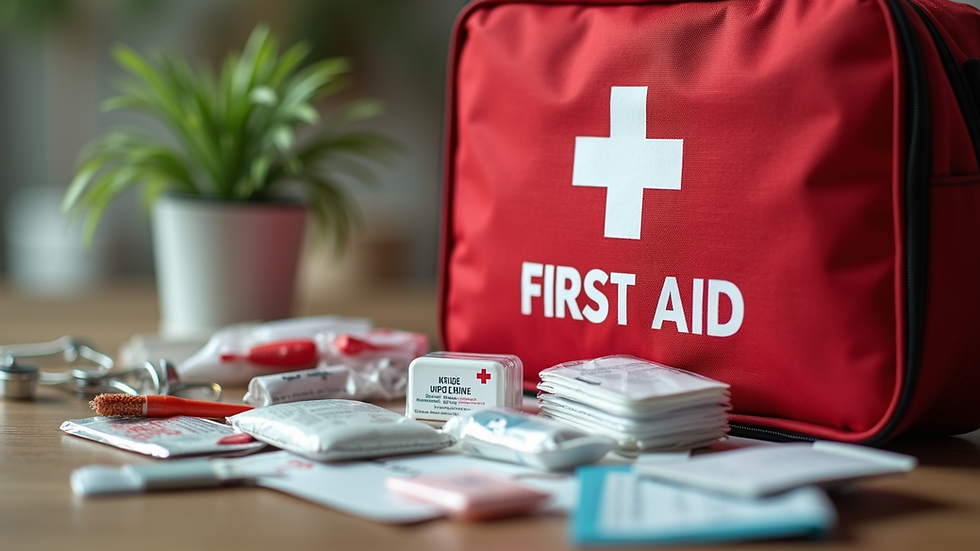Comprehensive Guide to Paediatric First Aid
- Aryeh Goldberg

- Nov 17
- 4 min read
When it comes to caring for children, knowing how to respond in an emergency can make all the difference. Accidents happen quickly, and being prepared with the right knowledge and skills is essential. This guide will walk you through the key child first aid essentials, helping you feel confident and ready to act when needed.
Understanding Child First Aid Essentials
Child first aid essentials cover the basic skills and knowledge required to provide immediate care to children who are injured or unwell. These skills are crucial because children are more vulnerable to accidents and illnesses than adults. Their bodies respond differently, and their needs vary depending on their age and development.
Some of the most important child first aid essentials include:
Recognising signs of choking, breathing difficulties, and allergic reactions
Knowing how to perform CPR on infants and children
Treating minor cuts, burns, and fractures
Managing fever and seizures safely
Understanding when to seek professional medical help
By mastering these essentials, you can provide calm and effective care that could save a child’s life or prevent a condition from worsening.

Why Learning Child First Aid is Important
Children are naturally curious and often unaware of potential dangers. This makes them prone to accidents at home, school, or playgrounds. Having the skills to respond quickly can reduce the severity of injuries and improve recovery outcomes.
For example, if a child is choking on a small object, knowing how to perform the correct back blows and chest thrusts can clear their airway immediately. Similarly, recognising the early signs of an allergic reaction and administering an adrenaline auto-injector can prevent a life-threatening situation.
Moreover, learning child first aid empowers caregivers, teachers, and parents to act confidently rather than panic. It also promotes a safer environment by encouraging awareness and prevention of common hazards.
What is paediatric first aid?
Paediatric first aid refers to the specialised care given to infants and children in emergency situations before professional medical help arrives. It focuses on the unique needs of young patients, considering their size, anatomy, and common childhood illnesses or injuries.
This type of first aid training covers a wide range of scenarios, including:
CPR techniques adapted for babies and children
Managing choking incidents specific to smaller airways
Treating burns, cuts, and fractures with child-friendly methods
Handling seizures and febrile convulsions
Recognising signs of serious illness such as meningitis or asthma attacks
Many organisations offer certified courses in paediatric first aid that provide hands-on practice and up-to-date guidelines. These courses are invaluable for anyone regularly caring for children.

Practical Steps to Take in a Child Emergency
Knowing what to do in an emergency can save precious time. Here are practical steps to follow when a child needs first aid:
Stay calm and assess the situation - Quickly check for any immediate dangers to yourself or the child.
Check responsiveness - Gently tap and speak to the child to see if they respond.
Call for help - If the child is unresponsive or seriously injured, dial emergency services immediately.
Open the airway - Tilt the head back slightly and lift the chin to open the airway.
Check breathing - Look, listen, and feel for breathing for up to 10 seconds.
Perform CPR if needed - Use chest compressions and rescue breaths appropriate for the child’s age.
Treat injuries - Apply pressure to bleeding wounds, cool burns with running water, and immobilise suspected fractures.
Monitor the child - Keep the child warm and comfortable while waiting for professional help.
Remember, never give medication or food unless advised by a healthcare professional.
Tips for Creating a Child-Friendly First Aid Kit
Having a well-stocked first aid kit tailored for children is a key part of being prepared. Here are some tips to create an effective child-friendly kit:
Include child-sized items such as small bandages, adhesive plasters with fun designs, and gentle antiseptic wipes.
Add items for common childhood injuries like sting relief pads, cold packs, and burn dressings.
Keep emergency contact numbers and a first aid instruction leaflet inside the kit.
Store the kit in an accessible place known to all caregivers.
Regularly check and replace expired items to ensure everything is ready when needed.
A good first aid kit combined with knowledge can make a big difference in managing minor injuries quickly and effectively.
Encouraging Safety and Prevention
While knowing first aid is vital, preventing accidents is even better. Here are some simple ways to promote safety around children:
Childproof your home by securing cabinets, covering sharp edges, and using safety gates.
Supervise playtime especially near water, stairs, or busy roads.
Teach children about hazards in an age-appropriate way, such as not touching hot surfaces or sharp objects.
Keep emergency numbers visible and teach older children how to call for help.
Ensure toys and equipment are safe and age-appropriate.
By combining prevention with first aid knowledge, you create a safer environment that reduces the risk of injury.
Continuing Your First Aid Education
First aid guidelines and best practices evolve over time. It’s important to refresh your skills regularly and stay informed about new techniques. Consider:
Enrolling in certified courses like paediatric first aid to gain hands-on experience.
Attending workshops or refresher sessions every 1-3 years.
Reading trusted resources and updates from health organisations.
Practising skills with family or colleagues to build confidence.
Ongoing education ensures you remain prepared to provide the best care possible when it matters most.
Being equipped with child first aid essentials is a valuable skill that benefits everyone involved in a child’s life. Whether you are a parent, teacher, or caregiver, taking the time to learn and prepare can make a life-saving difference. Remember, quick action, calmness, and knowledge are your best tools in any child emergency.





Comments